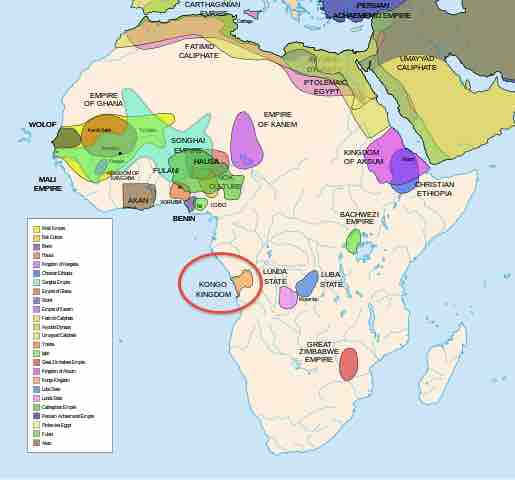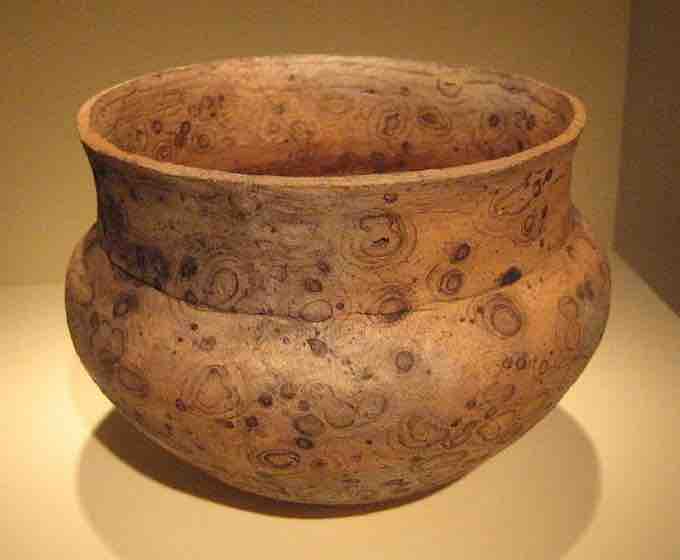The Kingdom of the Kongo was an African kingdom located in west central Africa in what is now northern Angola, Cabinda, the western portion of the Democratic Republic of the Congo, and the southernmost part of Gabon. At its greatest extent, it reached from the Atlantic Ocean in the west to the Kwango River in the east, and from the Congo River in the north to the Kwanza River in the south.

Map of precolonial Africa
The Kingdom of Kongo is circled in red.
The first king of the Kingdom was Lukeni lua Nimi (circa 1280-1320). By the time of the first recorded contact with the Europeans, the kingdom was a highly developed state at the center of an extensive trading network. Apart from natural resources and ivory, the country manufactured and traded copperware, ferrous metal goods, raffia cloth, and pottery. The eastern regions were particularly famous for the production of cloth.

An example of Kongo pottery
Made of ceramic and vegetable dye, such pottery was widely manufactured in the Kingdom of Kongo.
Artistically, the Kingdom of Kongo is perhaps best known for its nkisi (singular: minkisi), objects believed to be inhabited by spirits. Early travelers often called nkisi "fetishes" or "idols," as some were made in human form. Modern anthropology has generally called them either "power objects" or "charms." As in many African cultures, the Kongo religion placed great importance on communication with ancestors, believing that exceptional human powers could result from this communication. Nkisi were containers, such as ceramics vessels, gourds, animal horns, or shells, that could hold spiritually charged substances. Sometimes considered "portable graves," elements like earth or relics from the grave of a powerful individual were often placed in the bellies of nkisi. The powers of the dead thus infuse the object and allow the ngaga (healer, diviner or mediator) to control it.
Nkisi were often used in divination practices, for healing, or for good fortune in hunting, trade, or sex. Most famously, nkisi take the form of anthropomorphic or zoomorphic wooden carvings. Birds of prey, dogs (closely tied to the spiritual world in Kongo theology), lightning, weapons, and fire are all common themes. The substances chosen for inclusion in nkisi are frequently called "bilongo" or "milongo" (singular nlongo) a word often translated as "medicine." However, their operation is not primarily pharmaceutical, as they are not applied to or ingested by the infirm. Rather they are frequently chosen for metaphoric reasons, such as correcting illicit behavior.
Minkisi
The light area on the figure’s abdomen is a glass “window” that would hold “medicine” used for correcting illicit or immoral behavior.
Nkondi - often referred to as "nail fetishes" - are an aggressive type of nkisi that are thought to be activated by having nails driven into them. Each nail or metal piece represents a vow, a signed treaty, and efforts to abolish evil. Although nkisi nkondi have probably been made since at least the sixteenth century, the specifically nailed figures were most likely made in the northern part of the Kongo in the nineteenth and early twentieth centuries.

Female power figure of the Vili people - Democratic Republic of Congo
While this figure was made by the Vili people, it is similar to the nkisi nkondi made by people in the Kongo Kingdom.
The name nkondi derives from the verb -konda, meaning "to hunt" and thus nkondi means "hunter" because they can hunt down and attack evildoers or enemies. The object's primary function is to house a spirit that can hunt down the source or sources of evil that threaten an individual or an entire village. While some nkondi figures appear relatively benign, like the example above, others assume more aggressive body language and facial expressions to demonstrate their ability to attack evildoers successfully.
Minkisi nkondi
This figure assumes a more aggressive facial expression and body language.
Some nkondi assume zoomorphic forms, such as this sculpture of a protective wild animal.
Detail of a zoomorphic nkondi
Wood, metal, and porcelain. Eighteenth-nineteenth century.